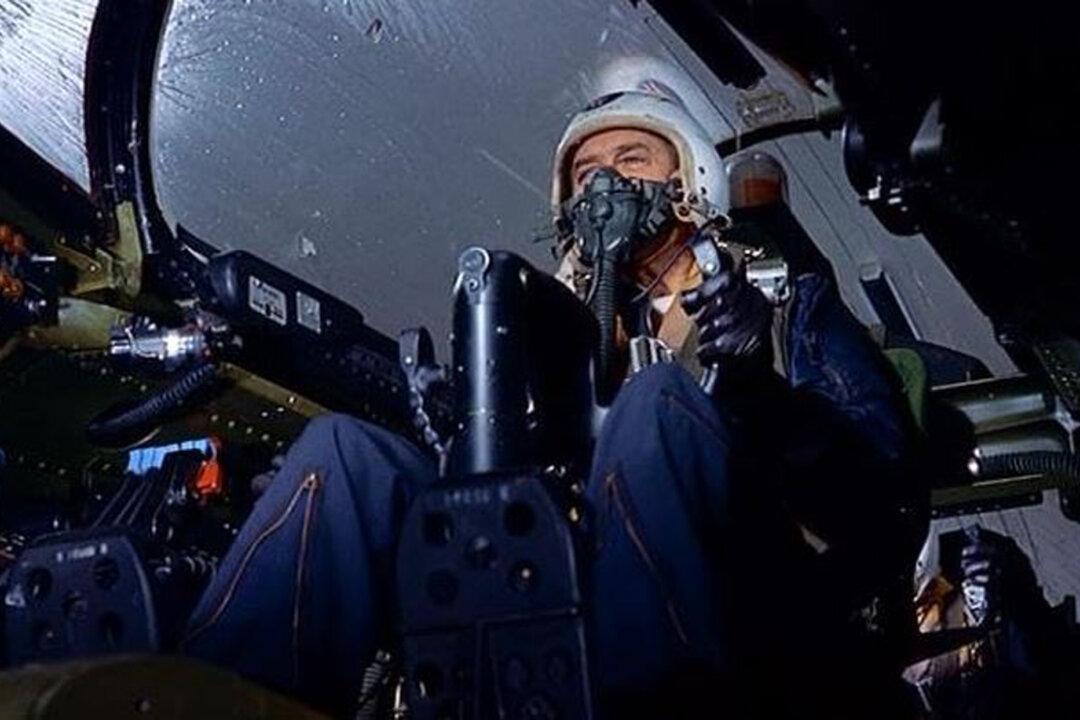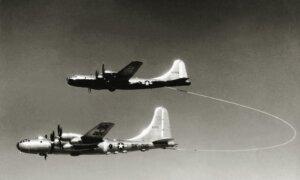A highpoint of their partnership was “Strategic Air Command” (1955), a movie about the early years of the Cold War that featured cutting-edge flight technology.

Stewart plays Robert “Dutch” Holland, a standout baseball player for the St. Louis Cardinals who also happens to be a lieutenant colonel in the United States Air Force. Dutch enjoys an idyllic life as a newlywed, married to Sally (June Allyson) for only five months. His days are filled with baseball and marital bliss. As a middle-aged, inactive reserve bomber pilot, he believes his combat duty days are well behind him.
Sally is visiting one of Dutch’s baseball practice sessions at the Al Lang Field in St. Petersburg, Florida when his old World War II buddy Maj. Gen. ‘Rusty’ Castle (James Millican) shows up. Dutch invites Rusty to his housewarming party, believing Gen. Castle came for social reasons.
At the party, Gen. Castle reveals the true reason for his visit: The Air Force is facing a shortage of experienced bomber pilots and needs Dutch to return to active duty. Since Dutch enjoys his new marriage and relatively tranquil life, he’s not enthused, especially since he’ll have to serve 21 months as part of the Strategic Air Command (SAC) unit of the Air Force. The deployment will impact the last able-bodied baseball time he has left. However, as a duty-bound airman, Dutch complies.

Although Sally isn’t thrilled to hear that her new husband is going back into active duty, she remains his devoted and loving wife, telling him “Anything you do is fine with me … as long as you don’t leave me behind.”
Dutch reports to his duty station at Carswell Air Force Base in Fort Worth, Texas, which houses SAC’s headquarters.
Met by Gen. Castle, Dutch meets the base commander, Gen. Ennis C. Hawkes (Frank Lovejoy), and the rest of his chain of command. As Dutch flew an older B-29 bomber during World War II, he now has to qualify to fly the newer Convair B-36 “Peacemaker” strategic bomber.

At a Crossroads
This movie debuted at a fascinating time in history. By the mid-1950s, Hollywood had embraced the new era of aviation with films featuring sleek jet planes, appealing to audiences familiar with pulp sci-fi heroes like Flash Gordon. While some movies were rushed, others, like Howard Hughes’s “Jet Pilot” (1957), simply fell short due to outdated aircraft as it was filmed in the late 1940s.In contrast, this film earned its place in cinema history for its meticulous attention to detail in depicting the aircraft and operations of the U.S. Air Force during its heyday. The breathtaking aerial cinematography and accurate portrayal of several iconic bombers have captivated aviation enthusiasts for decades.
Stewart, an airman who flew combat missions during World War II, believed strongly in the SAC’s mission and received Air Force approval to make this film. The SAC stood as the nation’s premier defense force, always prepared to deter potential threats. Amidst rising tensions with the Russians in the 1950s, the SAC’s role as the West’s shield against potential attacks became vital. Its rigorous training mirrored wartime conditions, guaranteeing quick and effective responses when necessary.

Stewart’s performance as Dutch Holland embodies the quintessential American hero, showcasing unwavering determination and a deep sense of duty.
This film unabashedly celebrates American patriotism. It pays homage to the bravery, dedication, and selflessness of the airmen who served with the SAC, even if it meant making sacrifices in their domestic lives. Far from being outdated, the film’s patriotic themes are as meaningful now as they were back then, serving as a reminder of the values that define the United States of America.








